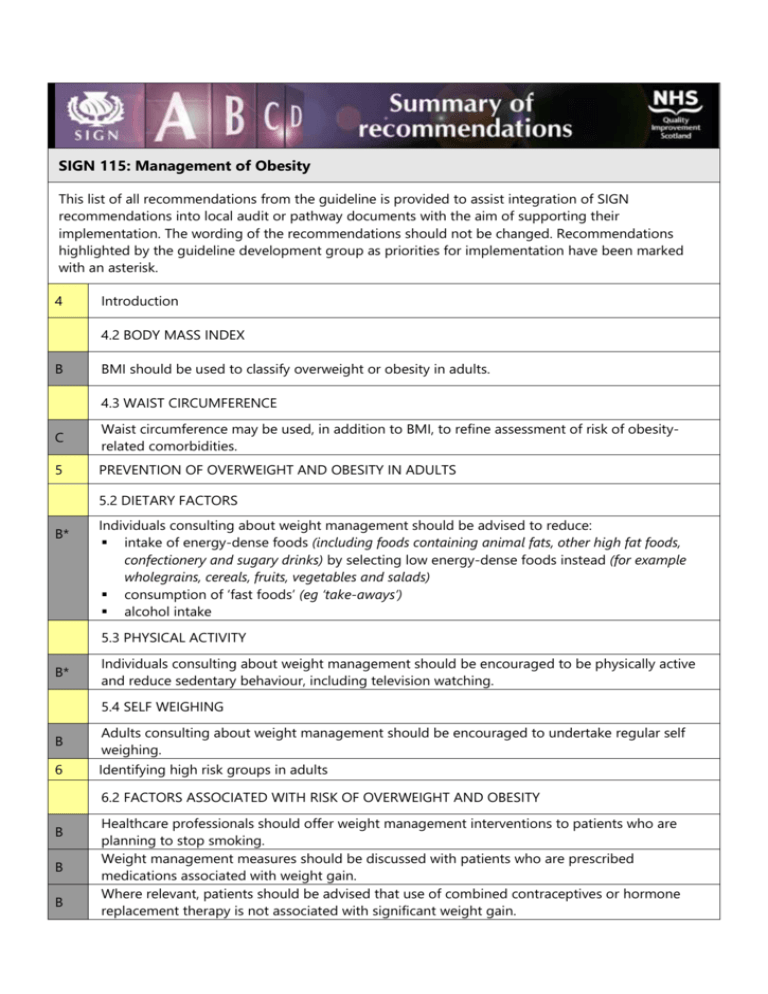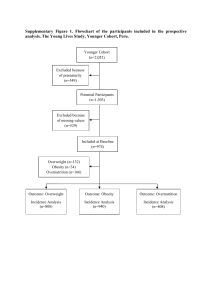recommendations115
advertisement

SIGN 115: Management of Obesity This list of all recommendations from the guideline is provided to assist integration of SIGN recommendations into local audit or pathway documents with the aim of supporting their implementation. The wording of the recommendations should not be changed. Recommendations highlighted by the guideline development group as priorities for implementation have been marked with an asterisk. 4 Introduction 4.2 BODY MASS INDEX B BMI should be used to classify overweight or obesity in adults. 4.3 WAIST CIRCUMFERENCE C Waist circumference may be used, in addition to BMI, to refine assessment of risk of obesityrelated comorbidities. 5 PREVENTION OF OVERWEIGHT AND OBESITY IN ADULTS 5.2 DIETARY FACTORS B* Individuals consulting about weight management should be advised to reduce: intake of energy-dense foods (including foods containing animal fats, other high fat foods, confectionery and sugary drinks) by selecting low energy-dense foods instead (for example wholegrains, cereals, fruits, vegetables and salads) consumption of ‘fast foods’ (eg ‘take-aways’) alcohol intake 5.3 PHYSICAL ACTIVITY B* Individuals consulting about weight management should be encouraged to be physically active and reduce sedentary behaviour, including television watching. 5.4 SELF WEIGHING B Adults consulting about weight management should be encouraged to undertake regular self weighing. 6 Identifying high risk groups in adults 6.2 FACTORS ASSOCIATED WITH RISK OF OVERWEIGHT AND OBESITY B B B Healthcare professionals should offer weight management interventions to patients who are planning to stop smoking. Weight management measures should be discussed with patients who are prescribed medications associated with weight gain. Where relevant, patients should be advised that use of combined contraceptives or hormone replacement therapy is not associated with significant weight gain. 7 Health benefits of weight loss in adults 7.8 RECOMMODATIONS A B 8 improved lipid profiles reduced osteoarthritis-related disability. lowered all-cause, cancer and diabetes mortality in some patient groups reduced blood pressure improved glycaemic control reduction in risk of type 2 diabetes potential for improved lung function in patients with asthma. Assessment in adults 8.2 ASSESSING MOTIVATION FOR BEHAVIOUR CHANGE D Healthcare professionals should discuss willingness to change with patients and then target weight loss interventions according to patient willingness around each component of behaviour required for weight loss, eg specific dietary and/or activity changes. 8.4 BINGE-EATING DISORDER C Healthcare professionals should be aware of the possibility of binge-eating disorder in patients who have difficulty losing weight and maintaining weight loss. 9 Weight management programmes and support for weight loss maintenance in adults 9.4 DIET PLUS PHYSICAL ACTIVITY PLUS BEHAVIOURAL THERAPY A Weight management programmes should include physical activity, dietary change and behavioural components. 9.5 INTERNET-BASED WEIGHT MANAGEMENT PROGRAMMES B Delivery of evidence based weight management programmes through the internet should be considered as part of a range of options for patients with obesity. 10 Dietary interventions in adults 10.8 RECOMMODATIONS A D 11 Dietary interventions for weight loss should be calculated to produce a 600 kcal/day energy deficit. Programmes should be tailored to the dietary preferences of the individual patient. Where very low calorie diets are indicated for rapid weight loss, these should be conducted under medical supervision. Physical activity in adults 11.3 PHYSICAL ACTIVITY DOSE A B Overweight or obese individuals should be supported to undertake increased physical activity as part of a multicomponent weight management programme. Overweight and obese individuals should be prescribed a volume of physical activity equal to approximately1,800-2,500 kcal/week. This corresponds to approximately 225-300 min/week of moderate intensity physical activity (which may be achieved through five sessions of 45-60 minutes per week, or lesser amounts of vigorous physical activity). 12 Psychological/behavioural interventions in adults A Individual or group based psychological interventions should be included in weight management programmes. 13 Pharmacological treatment in adults 13.1 ORLISTAT A Orlistat should be considered as an adjunct to lifestyle interventions in the management of weight loss. Patients with BMI ≥28 kg/m2 (with comorbidities) or BMI ≥30 kg/m2 should be considered on an individual case basis following assessment of risk and benefit. 14 Bariatric surgery in adults 14.7 RECOMMODATIONS C C 17 Bariatric surgery should be considered on an individual case basis following assessment of risk/benefit in patients who fulfil the following criteria: BMI ≥35 kg/m2 presence of one or more severe comorbidities which are expected to improve significantly with weight reduction (eg severe mobility problems, arthritis, type 2 diabetes). Binge-eating disorder, dysfunctional eating behaviour, past history of intervention for substance misuse, psychological dysfunction or depression should not be considered absolute contraindications for surgery. Diagnosis and screening in children and young people 17.2 DIAGNOSIS OF OVERWEIGHT AND OBESITY IN CHI LDREN AND YOUNG PEOPLE C BMI centiles should be used to diagnose overweight and obesity in children. C Waist circumference should not be used to diagnose overweight and obesity in children. D D 18 International obesity task force cut-offs should not be used to diagnose overweight and obesity in children. For clinical use, obese children are those with a BMI ≥98th centile of the UK 1990 reference chart for age and sex. Prevention of overweight and obesity in children and young people 18.5 RECOMMENDATION C Sustainable school based interventions to prevent overweight and obesity should be considered by and across agencies. Parental/family involvement should be actively facilitated. 19 Treatment of obesity in children and young people 19.1 LIFESTYLE INTERVENTIONS B Treatment programmes for managing childhood obesity should incorporate behaviour change components, be family based, involving at least one parent/carer and aim to change the whole family’s lifestyle. Programmes should target decreasing overall dietary energy intake, increasing levels of physical activity and decreasing time spent in sedentary behaviours (screen time). 19.2 PLANNING TREATMENT D In most obese children (BMI ≥98th centile) weight maintenance is an acceptable treatment goal. D For children with a BMI ≥99.6th centile a gradual weight loss to a maximum of 0.5–1.0 kg per month is acceptable. Weight maintenance and/or weight loss can only be achieved by sustained behavioural changes, eg: D D D healthier eating, and decreasing total energy intake increasing habitual physical activity (eg brisk walking). In healthy children, 60 minutes of moderate-vigorous physical activity/day is recommended reducing time spent in sedentary behaviour (eg watching television and playing computer games) to<2 hours/day on average or the equivalent of 14 hours/week. In overweight children (91st to <98th BMI centile) weight maintenance is an acceptable goal. Annual monitoring of BMI centile may be appropriate to help reinforce weight maintenance and reduce the risk of overweight children becoming obese. The following groups should be referred to hospital or specialist paediatric services before treatment is considered: children who may have serious obesity-related ƒ. morbidity that requires weight loss (eg benign intracranial hypertension, sleep apnoea, obesity hypoventilation syndrome, orthopaedic problems and psychological morbidity) children with a suspected underlying medical (eg endocrine) cause of obesity including all children under 24 months of age who are severely obese (BMI ≥99.6th centile). 19.3 PHARMACOLOGICAL TREATMENT IN YOUNG PEOPLE D Orlistat should only be prescribed for severely obese adolescents (those with a BMI ≥99.6th centile of the UK 1990 reference chart for age and sex) with comorbidities or those with very severe to extreme obesity (BMI ≥3.5 SD above the mean of the UK 1990 reference chart for age and sex) attending a specialist clinic. There should be regular reviews throughout the period of use, including careful monitoring for side effects. 19.4 surgical treatment in young people D Bariatric surgery can be considered for post pubertal adolescents with very severe to extreme obesity (BMI ≥3.5 SD above the mean on 1990 UK charts) and severe comorbidities.








